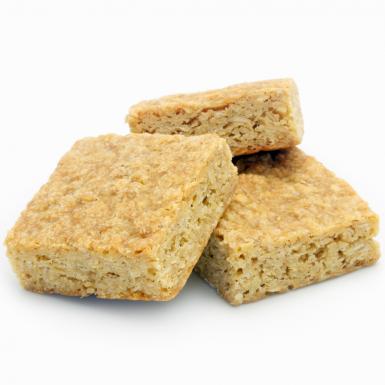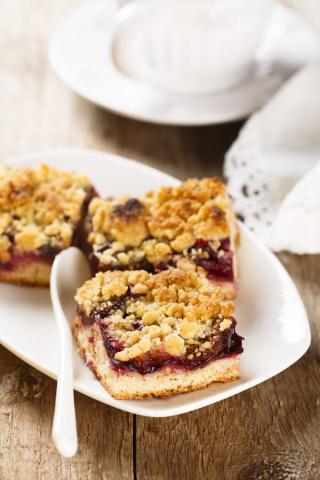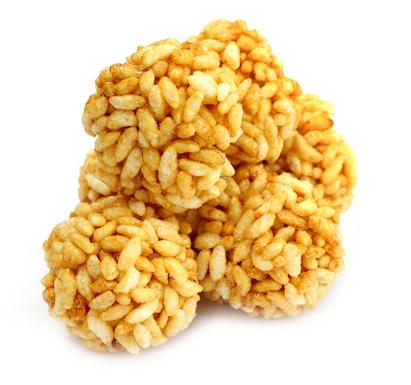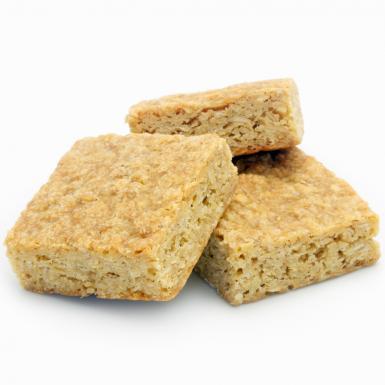- 1 Cup (112g) Porridge Oats
- 5 Tablespoons (70g) Low Fat Spread
- 1 Tablespoon (25g) Golden Syrup
- 1 Tablespoon (20g) Sugar
- 1 Heaped Spoonful Tablespoon (30g) Plain Flour
- 1 (20g) Apple
Ingredients
Allergy Disclaimer
Always check the label of each ingredient for allergy warnings.
Method
- Turn oven on to 180°C / 160°C fan oven / 350°F / gas mark 4. Peel, then finely chop or grate apple.
- Melt low fat spread in a pan over a low heat.
- Add sugar and syrup to the pan and continue to heat gently until sugar dissolves.
- Take pan off heat and mix in the apple, flour and porridge oats.
- Place mixture in a greased baking tray and spread the mixture so it is approximately 2 cm thick, smooth with the back of a spoon.
- Bake in the oven for 15-20 minutes until golden around the edges. Remove from the oven and leave to cool, then cut into portions while still warm.
Tips for Kids
Kids will love helping make this. You could even use cutters to make it into fun shapes. Why not add a handful of sultanas or other dried fruit to your recipe? You could even try using treacle or honey instead of syrup, or add a pinch of cinnamon – easy ways to see which different flavours your wee one finds tasty. As this recipe contains added sugar it’s best kept to mealtimes.
Nutritional Information
Based on a single serving of 81g (% of an adult's reference intake)
Energy
225 kcals ( 11 %)
987 kJ ( 11 %)
Fat
2 g ( 10 %)
Saturates
33.7 g ( %)
Sugar
13.9 g ( 15 %)
Salt
0.3 g ( 5 %)
Detailed nutritional information
| Per 100g | Per 81g serving | |
|---|---|---|
| Energy Kcals | 278 | 225 |
| Energy Kj | 1,168 | 987 |
| Protein | 5.3 g | 4.3 g |
| Total Fat | g | g |
| Saturated Fat | 2.4 g | 2 g |
| Carbohydrates | 41.6 g | 33.7 g |
| Total Sugars | 17.1 g | 13.9 g |
| NSP Fibre | 3.4 g | 2.7 g |
| Sodium | 163 mg | 132 mg |
| Salt | 0.4 g | 0.3 g |
Find out about nutritional labelling
Nutrition labels on the front of packaging
- Most of the big supermarkets and many food manufacturers display nutritional information on the front of pre-packed food.
- Front of pack nutrition labels provide information on the number of grams of fat, saturated fat, sugars and salt and the amount of energy (in kJ and kcal) in a serving or portion of a recipe.
- The labels also include information about reference intakes (expressed as a percentage) which are guidelines about the approximate amount of particular nutrients and energy required for a healthy diet.
- The colour coding tells you at a glance if the food has high (red), medium (amber) or low (green) amounts of fat, saturated fat, sugars and salt.
- The more greens on the label, the healthier the choice
- Amber means neither high nor low, so you can eat foods with all or mostly ambers on the label most of the time.
- Reds on the label means the food is high in that nutrient and these are the foods we should cut down on. Try to eat these foods less often and in small amounts.
Food shopping tips
If you’re trying to decide which product to choose, check to see if there's a nutrition label on the front of the pack. This will help you to quickly assess how your choices stack up. You will often find a mixture of red, amber and green colour coding for the nutrients. So when you're choosing between similar products, try to go for more greens and ambers and fewer reds if you want to make a healthier choice.
 Activities & Play
Activities & Play Behaviour
Behaviour Childcare
Childcare Development & Growing Up
Development & Growing Up Family, Friends & Relationships
Family, Friends & Relationships Feeding Your Baby
Feeding Your Baby Food & Eating
Food & Eating Health & Safety
Health & Safety Mental Health & Wellbeing
Mental Health & Wellbeing Money & Work
Money & Work Online Behaviour & Safety
Online Behaviour & Safety Pregnancy & First Days
Pregnancy & First Days School & Education
School & Education Sleep
Sleep




























